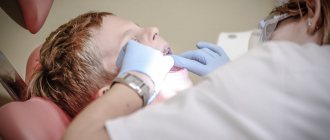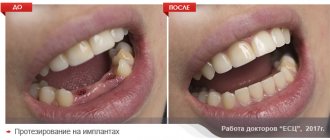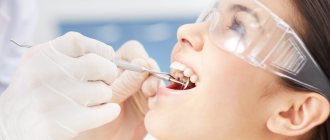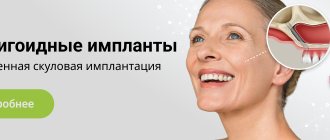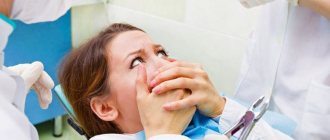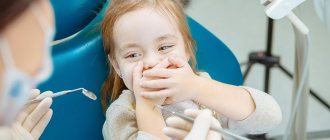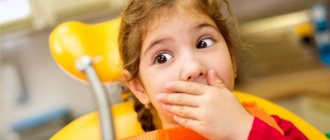Dental treatment is an unpleasant business. And children simply don’t understand why expose themselves to such pain. Therefore, dentists often behave inappropriately, cry, cover their mouths and interfere with procedures.
Many parents think about anesthesia as a solution if their child is afraid of the dentist, but needs treatment. And if 15 years ago this service seemed impossible, today many clinics offer treatment in this way.
Is it possible to remove or treat a child’s teeth under general anesthesia? Are there any alternatives to it? Let's figure it out together.
Pediatric anesthesia in dentistry
First, let's figure out what anesthesia is. This is a reversible inhibition of the activity of the central nervous system, which we cause artificially.
Narcosis is characterized by:
- falling asleep and decreased reflexes;
- loss of consciousness and muscle relaxation;
- complete absence of painful sensations.
Translated into simple language, this means that during general anesthesia the child falls deeply asleep, lies motionless during the procedure and does not feel anything. And after waking up he doesn’t remember anything.
They are immersed in this state using a combination of several drugs, which ensures safety and comfort for the baby. At the same time, safety comes first. Modern methods of general anesthesia completely eliminate the negative impact on the mental and physical development of a small patient.
Unlike adult dentistry, in pediatric dentistry there is no intermediate option between superficial sedation and anesthesia. This means that for children under 16 years of age there are only two options for “sleep treatment”: superficial sedation, when the child remains awake during treatment, and general anesthesia (endotracheal anesthesia). This is due to the anatomical and physiological characteristics of children. Because of them, deep intravenous sedation is impossible.
Which is safer: Sevoran or Propofol for children?
The doctor should take part in deciding which drug to use for treatment, whether to give the child propofol or sevoran. In terms of effectiveness and safety, these drugs are almost identical - Sevoran is slightly (several percent) ahead of Propofol, but it is more convenient to administer Propofol, since during dental procedures intravenous administration through an infusion pump is better, which makes it easier to control the dosage than administration of gaseous Sevoran through a special mask.
But the most important thing is that Propofol and Sevoran have different active ingredients, so their safety, effectiveness and possibility of use may differ in any particular case due to the individual characteristics of the child’s body (for example, the presence of an allergy to a certain substance) and this can be determined only a doctor.
Should children undergo dental treatment under anesthesia when they cry?
If your baby cries at the dentist, he may just be very emotional. And then, to calm him down, kind words are enough.
An experienced doctor knows how to find a common language with children, and there are usually no difficulties with treatment. There are many adaptive techniques when the doctor explains to the child in a playful manner that treatment is interesting and not painful at all. In addition, to cope with your baby’s fear, you can use the help of a psychologist.
If these methods do not help, then you can try the procedure under sedation. It muffles fear and temporarily dulls the baby's reactions.
Tears are not a good reason to perform dental treatment under anesthesia in children. It is worth resorting to it only if other methods of “agreeing” have not been successful. Anesthesia in pediatric dentistry is used if there are indications for it.
Treatment of baby teeth under anesthesia is carried out:
- if it is impossible to establish contact with the baby;
- dental treatment for children under 3 years of age;
- allergies to local anesthesia;
- mental illnesses or nervous system disorders: schizophrenia, epilepsy, Parkinson's disease, cerebral palsy, mental retardation;
- insurmountable fear of dental treatment (scientifically called dentophobia);
- strong gag reflex, which interferes with the treatment of distant teeth;
- extensive surgical operations: complex tooth extraction, abscesses, periostitis, lymphadenitis, serious jaw injuries.
When children should not use anesthesia for dental treatment:
✔
during the acute course of the infectious process;
✔
with decompensation of severe chronic diseases.
In general, there are no absolute contraindications to general anesthesia in children. Sometimes you just need to wait for the right moment or choose the most suitable technique. If the baby has an acute situation - pain or injury - there is always the opportunity to safely and comfortably undergo treatment under anesthesia.
Preparing your child for a trip to the dental clinic
Of course, under no circumstances should you put off your first trip to the dentist until a critical situation occurs. It is necessary, at a time when there is no worry, to take the child to the doctor, to show him that the dental chair is not at all scary, and the prevention of dental diseases helps to avoid serious problems. In addition, you can encourage your child’s calm behavior with something pleasant for him (but not sweets). Thus, the child’s fear and anxiety towards the doctor are minimized. It is also worth noting that children under three years of age have a reduced pain threshold and thus you can fearlessly take a very young child to the doctor, without fear for him and reinforcing the correct perception of the doctor as an assistant in maintaining health.
Among other things, be sure to provide psychological preparation to your child, talk to him and explain the benefits of regular visits to the doctor. Ask your child what worries him about the upcoming trip to the dental clinic, and do not let him instill fear in himself. Be calm and confident, and your good mood will definitely be passed on to your child.
In addition, you can prepare your child for a trip to the doctor by taking him with you to an adult clinic and demonstrating by personal example that there is nothing wrong with this. However, it is worth warning the doctor about the presence of the child, explaining the rules of behavior and choosing a time for visiting with the least number of patients, so as not to disturb the baby.
However, even if all of the above tips have been taken into account, they do not always guarantee that the child will not worry at all before going to the doctor. It may also happen that it will not be possible to implement all the recommendations on time. In any case, under certain circumstances, parents begin to become interested in the possibility of performing dental procedures with minimal discomfort for the child. As a rule, the first thing that comes to mind is general anesthesia. And if earlier the idea of dentistry under general anesthesia, especially for a small child, seemed completely impossible, now many clinics provide such a service. However, before going for it, it is necessary to arm yourself with the most complete knowledge about the procedure.
How to prepare a child for dental treatment under anesthesia
- Before treatment, you should consult with an anesthesiologist. This can usually be done over the phone, but in some cases a face-to-face appointment is required.
To correctly administer general anesthesia, the anesthesiologist will need the following information:
- child development history;
- allergic reactions;
- past acute and chronic diseases;
- previous medical interventions and hospitalizations;
- anthropometric data (age, height, weight).
To clarify the child’s health status, you will need to undergo a series of tests. The anesthesiologist determines the full scope of the required examination based on the characteristics of the small patient and the type of upcoming treatment.
- Before anesthesia, diet is very important. The safety of anesthesia depends on its compliance.
The child who will best tolerate anesthesia is the one who:
- did not eat “heavy food” during the 6 hours preceding treatment;
- 4 hours before the procedure I had a snack;
- I drank water 2 hours before.
Dietary recommendations may vary, so the final meal plan will be discussed in consultation with the anesthesiologist.
- To help parents not be nervous, I also recommend asking the anesthesiologist what his qualifications are and what equipment he will use during the procedure. You definitely shouldn’t be embarrassed about such questions. Doctors with experience in pediatric anesthesiology should work with children, since the structure of the child’s body and its functioning have their own characteristics.
Contraindications to the use of Propofol
The number of contraindications to the use of Propofol is small - it is an allergy to chicken yolk, since its components are included in the drug as an adjuvant. Also, in the presence of serious diseases of the cardiovascular system, liver or kidneys, as well as disorders of lipid (fat) metabolism, the use of the drug is not recommended, but it is possible with the permission of the attending physician.
Temporary contraindications requiring postponement of surgery under Propofol are recent diseases of the respiratory system (ARVI, bronchitis, etc.), as well as vaccination against viral infections.
The use of Propofol anesthesia for children is not a contraindication for epilepsy, but requires mandatory consultation with a specialized doctor and the prescription of anticonvulsants during surgery.
How is dental treatment performed for children under anesthesia?
During treatment under general anesthesia, the child does not feel anything. And he doesn’t remember anything after waking up. This is achieved by a combination of drugs. The main one among them is Sevoran.
The combination of drugs and their doses are calculated individually for each child. In this case, the doctor takes into account the age, weight and characteristics of the small patient. The use of combinations of anesthetics makes it possible to minimize their doses and carry out a high-quality and safe procedure.
The child falls asleep after a few breaths through the mask of the anesthesia machine. This happens in the arms of the mother. We perform induction of anesthesia as comfortably as possible for the baby. If a child comes with his favorite toy, we show her by example: inhalation from a mask is not scary.
In cases where parents warn the anesthesiologist that even a mask causes negative emotions in the child, premedication can be used. Then we administer a mild sleeping pill to the baby in the form of nasal drops, after which the child plays or watches cartoons for 30-40 minutes and gradually falls asleep in his mother’s arms. And then we begin induction of anesthesia.
An anesthesiologist and a nurse anesthetist are responsible for administering general anesthesia. Their interaction ensures the safety of the child. The baby is under constant control, precisely calculated doses of drugs are administered at the appropriate time. It takes approximately 30 minutes in addition to the treatment time for the anesthesiologist to induce anesthesia and wake up.
Reviews
The first visit to the dentist can be a daunting experience for children and their parents. In each of the clinics of the Natadent network, we have created a truly warm and comfortable environment. We welcome every feedback - you help us become better.
LEAVE FEEDBACK
What is rehabilitation like after treatment under anesthesia?
After waking up from anesthesia, in the vast majority of cases, children feel well. Most often, the only thing that bothers them is numbness in the areas where the local anesthetic was injected.
As for behavioral changes, there are three types:
- excitement - the baby may be capricious and cry. This is accompanied by increased activity. But it quickly gives way to fatigue;
- fatigue - the child wants to sleep, refuses to eat, sits in the arms of the parents;
- no behavioral changes after waking up.
The first two scenarios are typical for children under the age of 7-10 years, the third - for adolescents and adults.
Hyperactivity and agitation upon awakening are unpleasant for both the child and those around him. To avoid it, we try to implement the second scenario; to do this, we put the baby to sleep and wake him up gently.
The child can eat immediately after waking up, unless the anesthesiologist gives other recommendations.
Very rarely, recovery from anesthesia is accompanied by nausea or a feeling of motion sickness. This lasts no longer than 2-3 hours. This reaction is typical for children who get motion sickness in transport. In this case, you will be able to eat and drink within an hour or after the nausea has passed.
There is no need to worry about the postoperative period - the anesthesiologist will always be in touch.
Medical sedation
Medical sedation is an intermediate link between general and local anesthesia. The essence of the technique is for the child to inhale gas vapors (usually nitrous oxide). As a result, the excitement of the nervous system decreases, reactions and fear are dulled, but the little patient remains conscious, breathes independently and can follow the doctor’s commands.
The procedure is harmless to the body and helps to carry out even long-term manipulations without exposing the child to excessive stress. As a rule, sedation is combined with local anesthesia.

